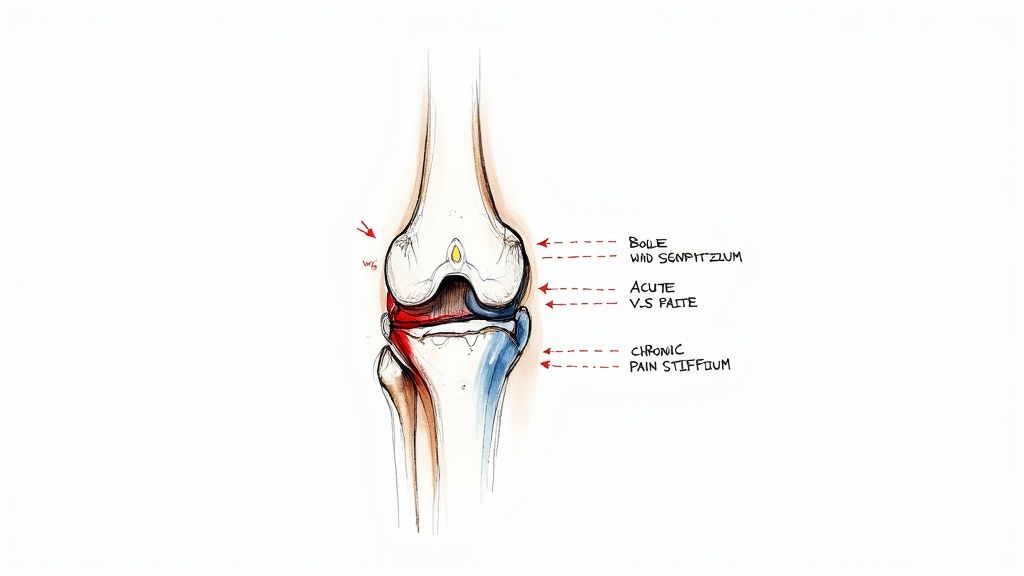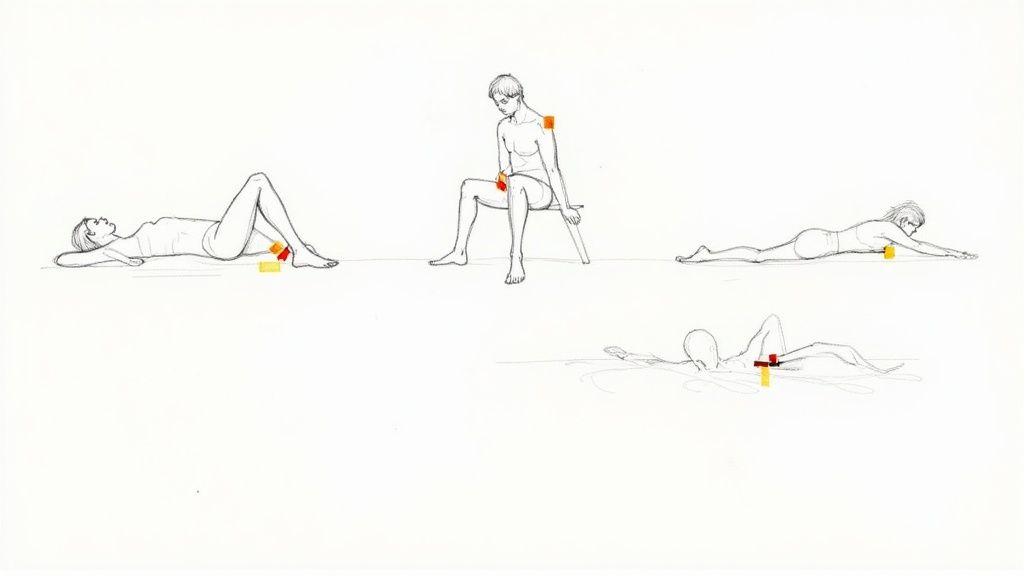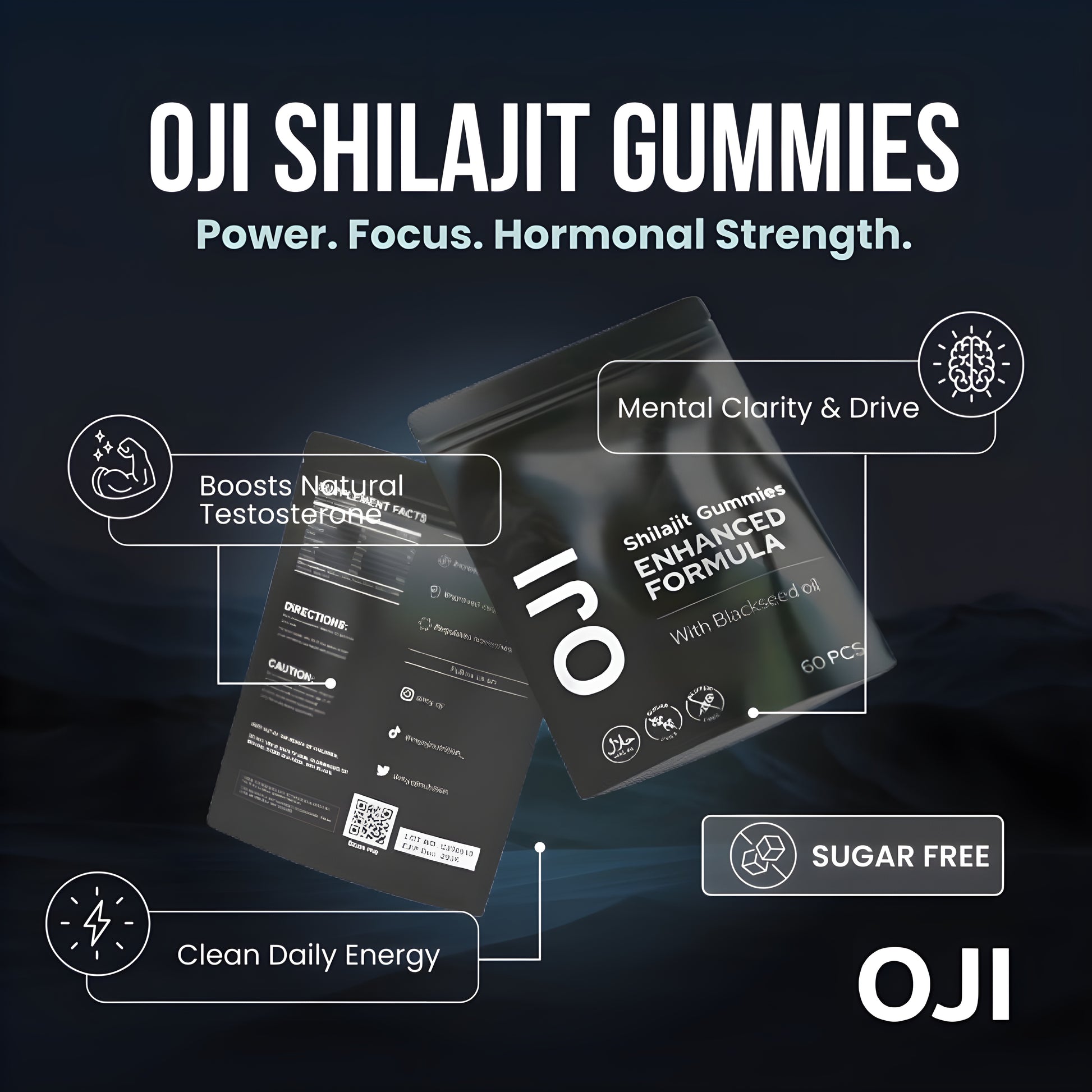Before you can learn how to reduce inflammation in your joints, you need to know what you’re up against. The best approach is a holistic one that targets the root causes of your pain and stiffness—think diet, movement, and lifestyle—rather than just temporarily masking the symptoms.
Getting this foundation right is what empowers you to make meaningful changes that bring real, lasting relief.
What Is Happening Inside Your Joints

When you feel that all-too-familiar ache, throb, or stiffness in a joint, it’s a direct signal from your body’s immune system. Inflammation is simply the body's natural response to an injury or threat, where it rushes immune cells and fluid to the site to kickstart the healing process.
Think of it as your internal emergency service. If you twist your ankle, this response is fast, localised, and absolutely essential for repair. This is what we call acute inflammation.
The problem starts when this response system gets stuck in the ‘on’ position. When inflammation hangs around for months or even years, it becomes chronic inflammation—a persistent, low-level irritation that can slowly and steadily damage your joint tissues.
Distinguishing Between Acute and Chronic Inflammation
Understanding the difference here is key. Acute inflammation is a helpful, short-term healer. Chronic inflammation, on the other hand, is a long-term vandal that can degrade cartilage, the smooth, protective tissue that cushions your bones.
Once that cartilage wears away, bones can start to rub against each other. This is what causes the relentless pain associated with conditions like osteoarthritis.
This is far from a minor issue. In the UK, a staggering 17.9% of people aged 16 and over have reported a long-term musculoskeletal condition. That means nearly one in five adults is living with the daily effects of joint inflammation.
When the body's healing signal gets stuck 'on', it transitions from a helpful response to a destructive force. This is the essence of chronic joint inflammation.
Recognising the Key Signs
Learning to listen to your body is the first real step towards managing your joint health. The main signs of inflammation are often easy to dismiss as just 'getting older' or 'a bit of an ache', but they’re telling you an important story. Take action if you notice:
- Persistent Pain: A dull ache or a sharp throb in the joint, especially during or after you’ve been moving.
- Noticeable Swelling: The joint might look visibly larger than its counterpart or feel puffy to the touch because of fluid build-up.
- Stiffness: A real difficulty in moving the joint, which is often worst first thing in the morning or after you’ve been sitting still for a while.
- Redness and Warmth: The skin over the sore joint may appear reddish and feel warm, which is a sign of increased blood flow to the area.
If any of this sounds familiar, you’re certainly not alone. The journey back to comfort begins by recognising these signals and understanding what causes chronic inflammation. Once you pinpoint the ‘why’ behind the discomfort, you can start building a plan to reclaim your comfort and mobility.
Tweak Your Diet to Soothe Your Joints

The food you put on your plate can either add fuel to the fire of inflammation or help calm it right down. Easing joint pain with your diet isn't about bland meals or feeling deprived. It’s all about making smart additions and simple swaps to get powerful, pain-fighting compounds working for you.
Think of every meal as a chance to support your joints from the inside out. When you focus on whole, nutrient-packed foods, you’re giving your body the exact tools it needs to keep its inflammatory response in check. This is a cornerstone of learning how to reduce inflammation in joints for good.
This is especially true if you’re managing a specific condition. For example, rheumatoid arthritis (RA) is a major cause of joint inflammation in the UK, affecting at least 1.16% of women and 0.44% of men. While medical treatment is vital, lifestyle factors—especially diet—play a huge supportive role in managing the chronic inflammation it causes, as detailed in this in-depth rheumatology study.
Foods That Fight Back
Start by "crowding out" pro-inflammatory foods by filling your plate with colourful, antioxidant-rich alternatives. These are the foods that actively work to soothe your system.
Oily fish is a brilliant place to start. Varieties like salmon, mackerel, and sardines are bursting with omega-3 fatty acids, which are famous for their anti-inflammatory effects. Just two servings a week can start to make a real difference.
Beyond that, load up on vibrant fruits and vegetables. Things like berries, dark leafy greens (think spinach and kale), and broccoli are packed with antioxidants and vitamins that help fight cellular stress.
The golden rule for an anti-inflammatory diet is simple: eat more real food. Stick to foods that are as close to their natural state as possible, and your joints will thank you for it.
Foods to Enjoy Less Often
It’s not just about what you add, but also what you limit. Some foods are known to trigger or worsen inflammation, so being mindful of them is a game-changer.
The main culprits are usually ultra-processed items. Limit foods high in refined carbohydrates (like white bread and pastries), sugary drinks, and processed snacks. They can cause blood sugar spikes that kickstart an inflammatory response.
Likewise, fried foods and anything with trans fats (often labelled "partially hydrogenated oils") are best avoided. This doesn’t mean you can never have a treat, but it’s about making them the exception, not the everyday rule. For more tips that go beyond the kitchen, check out our guide on how to reduce inflammation naturally.
Your Anti-Inflammatory Shopping List
To make your next trip to the supermarket a bit easier, here’s a quick-reference guide to the foods that help and those that can hinder your progress.
| Food Category | Foods to Prioritise | Foods to Limit |
|---|---|---|
| Proteins | Oily fish (salmon, mackerel), lean poultry, beans, lentils | Processed meats (sausages, bacon), red meat in excess |
| Fats | Olive oil, avocados, nuts (walnuts, almonds), seeds (chia, flax) | Vegetable oils (sunflower, corn), trans fats, margarine |
| Carbohydrates | Wholegrains (oats, brown rice), sweet potatoes, quinoa, wholemeal bread | White bread, pastries, sugary cereals, white pasta |
| Fruits & Veg | Berries, leafy greens (spinach, kale), broccoli, cherries, tomatoes | Fruit juices with added sugar, heavily processed fruit snacks |
| Snacks & Drinks | Green tea, handful of nuts, dark chocolate (70%+ cocoa), water | Sugary drinks, crisps, biscuits, sweets |
Keep this list handy on your phone. The goal isn’t perfection, but consistent, positive choices that build up over time.
Simple Swaps for Everyday Meals
Making lasting changes is all about small, easy wins. Here are a few practical swaps you can try today:
- For breakfast: Ditch sugary cereal for a bowl of porridge topped with blueberries and walnuts. You get fibre, antioxidants, and healthy fats all in one.
- For lunch: Swap white bread for a wholemeal or rye loaf for your sandwiches. It’ll help keep your blood sugar stable.
- For cooking: Use extra virgin olive oil for salad dressings and light cooking instead of generic vegetable oil to get a dose of anti-inflammatory polyphenols.
- For snacking: Instead of reaching for crisps, grab a handful of almonds or walnuts. They provide healthy fats and that satisfying crunch without the inflammatory oils.
Moving to Soothe and Strengthen Your Joints

When your joints are screaming in protest, the absolute last thing you feel like doing is getting up and moving. The gut instinct is to stay put, protect the sore spot, and avoid anything that might make it worse.
But here’s the paradox: the right kind of gentle movement is actually one of the most powerful tools you have to fight back against joint inflammation.
Inactivity lets stiffness set in, making everything feel worse. Motion, on the other hand, acts like a natural lubricant for your joints. It encourages the production of synovial fluid, which is the body's own cushioning system for the ends of your bones. Plus, by strengthening the muscles around an aching joint, you’re building a better support system, which takes a huge amount of pressure off the joint itself.
The trick is to work with your body, not against it. Choose low-impact activities that build strength and flexibility without jarring those already sensitive areas.
Gentle Mobility Exercises You Can Do at Home
You absolutely don't need a fancy gym membership to make a difference. Simple, controlled movements you can do right at home will have a massive impact on your range of motion and that awful morning stiffness. Remember, consistency beats intensity every single time.
Integrate these movements into your day, perhaps while the kettle boils or during a break from your desk.
- Ankle Rotations: While sitting down, lift one leg out and slowly roll your foot clockwise ten times, then anti-clockwise. This tiny movement does wonders for a joint that carries your entire body weight.
- Seated Knee Lifts: Sit up straight in a chair, feet flat on the floor. Gently bring one knee up towards your chest, as far as feels good. Hold for a second, then slowly lower it back down. Aim for 10 of these on each side.
- Wrist Bends: Hold one arm out, palm facing down. Use your other hand to gently press your wrist down, holding the stretch for 15-30 seconds. Then repeat, bending it upwards. This is a game-changer for the small, delicate joints in your hands.
For more targeted routines to support your joints, you can also explore some great home physical therapy exercises for pain relief.
Expanding Your Low-Impact Routine
Once you're comfortable with those basics, start looking at other activities that are famously kind to joints while still giving you a brilliant workout.
Swimming and water aerobics are top of the list. The water's buoyancy supports your body weight, taking nearly all the pressure off your hips, knees, and spine. This frees you up to move and build strength without any painful impact.
Cycling is another fantastic choice, whether it's on a stationary bike or a gentle, flat path outside. It’s all about that smooth, repetitive motion which is perfect for strengthening the leg muscles—especially the quads, which are your knee joint's best friends.
The goal isn't to push through pain. It’s to find that 'feel-good' level of movement that gently chips away at stiffness and builds up your resilience over the long haul. Always listen to your body and back off immediately if you feel any sharp pain.
Even with all the known benefits, staying active can be a real struggle. Fatigue is a huge hurdle. One study, for example, found that only 40% of men with inflammatory joint disease were hitting the recommended activity levels. This just goes to show how vital it is to start small and, most importantly, find something you actually enjoy doing.
Building that consistent habit is what really matters. A daily 15-20 minute session of gentle movement is infinitely more valuable than one painful, intense workout a week. Start slow, notice the small wins, and build a routine that will keep your joints happy for years to come.
Daily Habits for Lasting Joint Relief
It’s not just about what you eat or how you move. The power of your daily routines over joint inflammation is enormous. If you ignore things like stress, sleep, and body weight, you can easily undo all your hard work, leaving you stuck in a frustrating cycle of pain.
Tweaking these parts of your life is a massive piece of the puzzle. These aren't just background details; they directly impact your body's inflammatory chemistry. When they're out of whack, they quietly add fuel to the fire you're trying so hard to put out.
Get a Handle on Your Stress
Chronic stress is a huge inflammation trigger. When your body is stuck in high-alert mode, it's constantly pumping out cortisol. Over time, this stress hormone throws your immune system off balance and encourages inflammation all over the body. This isn’t just in your head—your joints literally feel it.
The good news? You can actively manage this with some really simple techniques. Mindful breathing is one of the quickest ways to hit the reset button.
- Try the 4-7-8 Technique: Find a comfortable spot to sit or lie down. Breathe in quietly through your nose for 4 seconds, hold that breath for a count of 7, and then breathe out completely through your mouth for 8 seconds. Just doing this three or four times can instantly calm your nervous system.
Make Restorative Sleep a Priority
Sleep is your body's dedicated repair shift. During the deep stages of sleep, it produces special anti-inflammatory molecules called cytokines. When you don’t get enough sleep, that whole process gets cut short.
Getting less than 7-8 hours a night on a regular basis is directly linked to higher levels of inflammatory markers in the blood.
Think of sleep as the nightly maintenance crew for your joints. Skimping on it means the repair work doesn't get done, and inflammation can build up without anything to stop it.
Take action to improve your sleep hygiene. Go to bed and wake up at the same time, make sure your bedroom is dark and cool, and put away screens for at least an hour before you turn in.
Beyond diet and exercise, a truly anti-inflammatory lifestyle is key. For a wider look at natural approaches, you can find some great advice on how to reduce inflammation naturally.
Manage Your Weight to Lighten the Load
This might be one of the most impactful things you can do for your joints, especially the big weight-bearing ones like your hips and knees. It’s simple physics: for every extra pound of body weight, your knees feel about four extra pounds of pressure with every step you take.
This isn’t about chasing some ideal number on the scales. It's about easing the day-to-day mechanical stress on your joints.
Even a small weight loss—just 5-10% of your body weight—can slash your pain and dramatically improve how your joints function. Not only does this reduce the physical strain, but it also lowers inflammation, as excess fat tissue is known to produce its own inflammatory proteins. A sensible diet combined with gentle, consistent movement is the most sustainable way to get to a healthier weight for your joints.
Natural Supplements for Additional Joint Support

While your diet, daily movement, and lifestyle habits are the absolute cornerstones of managing joint health, certain supplements can give you some valuable extra backup. Think of them less as a magic fix and more as a helpful ally to complement everything else you’re doing.
The supplement world can feel a bit like the Wild West, so it’s smart to focus on options with solid research behind them. This way, you’re making an informed choice, not just taking a shot in the dark.
Before you start anything new, it is absolutely essential to have a chat with your GP or another qualified health professional. They can guide you on what might work best for your specific situation and make sure it won’t clash with any medications or health conditions you have.
Evidence-Backed Options for Joint Health
When it comes to calming down inflammation, a few key players have proven their worth time and time again in scientific studies. They work by targeting the specific pathways that trigger joint pain and swelling.
-
Turmeric (Curcumin): That vibrant yellow spice in your cupboard gets its power from curcumin, a potent anti-inflammatory compound. It works by actively blocking some of the key enzymes and proteins that fuel the inflammatory process. To get the most out of it, look for a supplement that also contains black pepper (piperine), which is known to dramatically boost how much curcumin your body can actually absorb.
-
Omega-3 Fish Oil: Omega-3 fatty acids, particularly EPA and DHA found in oily fish, are fantastic for joint health. Your body converts them into compounds that help to resolve inflammation, and they are among the most researched supplements out there for reducing joint stiffness and pain.
These are especially useful if you know your diet isn't consistently rich in these specific nutrients.
Exploring Natural Mineral Compounds
Beyond the usual suspects, certain natural mineral substances can also offer a helping hand. Some of these have been used in traditional wellness practices for centuries and are now catching the eye of modern science.
For instance, compounds rich in fulvic acid are prized for their antioxidant effects. Antioxidants are your body’s cleanup crew, helping to neutralise unstable molecules called free radicals that can cause cellular stress and contribute to chronic inflammation.
Making a smart choice comes down to looking at the quality, understanding how a supplement works, and always putting safety first by talking to your doctor.
Some people also look for ways to support the very building blocks of their joints. While your diet is always the best place to start, you can find out more about supporting your body’s structural proteins with options like these high-quality collagen peptide gummies. Adding a high-quality, well-researched supplement can give your body an extra edge in the fight against joint inflammation, helping you on your way to better comfort and mobility.
When It’s Time to See Your Doctor
Taking charge of your joint pain is fantastic, but it's just as important to know when to call in the professionals. While eating right, exercising, and managing your lifestyle are incredibly powerful ways to handle chronic inflammation, some symptoms are clear signals that you need a doctor's input. Ignoring these red flags could mean a delayed diagnosis and risk long-term damage to your joints.
Getting a proper diagnosis is the foundation of any good treatment plan. So many different things can cause joint inflammation, from wear-and-tear osteoarthritis to autoimmune conditions like rheumatoid arthritis. Each one needs a totally different approach, and your GP is the best person to help figure out what’s going on and get you started on the right path.
Don't Ignore These Warning Signs
Book an appointment if you experience any of the following. These symptoms can point to a more serious issue that needs medical intervention.
- Sudden, severe pain: If intense joint pain appears out of nowhere without an obvious injury, it's a definite sign to get it checked.
- Major swelling with redness or heat: A joint that’s visibly swollen, red, and warm to the touch could be a sign of an infection or a serious inflammatory flare-up.
- Pain plus a fever: This combination is a serious warning sign that should never be ignored.
- You can't move the joint: If you’ve lost your normal range of motion or can't put any weight on the joint, it’s time to see a professional.
Reaching out for medical help isn't a failure of your self-care plan. Think of it as a smart, proactive step to protect your joints for the long haul and make sure you’re tackling the right problem.
When Your Best Efforts Aren't Cutting It
It’s incredibly frustrating when you’re doing everything you’re supposed to—eating clean, moving gently, keeping stress low—and the pain is still getting worse. This is another crucial moment to check in with your doctor. If your symptoms are worsening despite your hard work, it suggests the root cause of your inflammation needs a more direct approach, perhaps with medication or other specialised treatments.
Think of your GP as a partner in your health journey. They can order the tests you need, like X-rays or blood tests, to get a clear picture of what’s happening inside your joints. From there, they can work with you on a tailored treatment plan or refer you to a specialist, like a rheumatologist or an orthopaedic surgeon, if needed. It’s all about making sure you’re using every tool available in your mission to reduce inflammation in joints.
At Oji Shilajit, we're all about supporting your wellness journey with the best nature has to offer. Our enhanced Shilajit gummies are made to complement a healthy lifestyle, giving you essential minerals and natural compounds to support your overall vitality. Find out how we can help you feel your best at https://myoji.co.uk.





